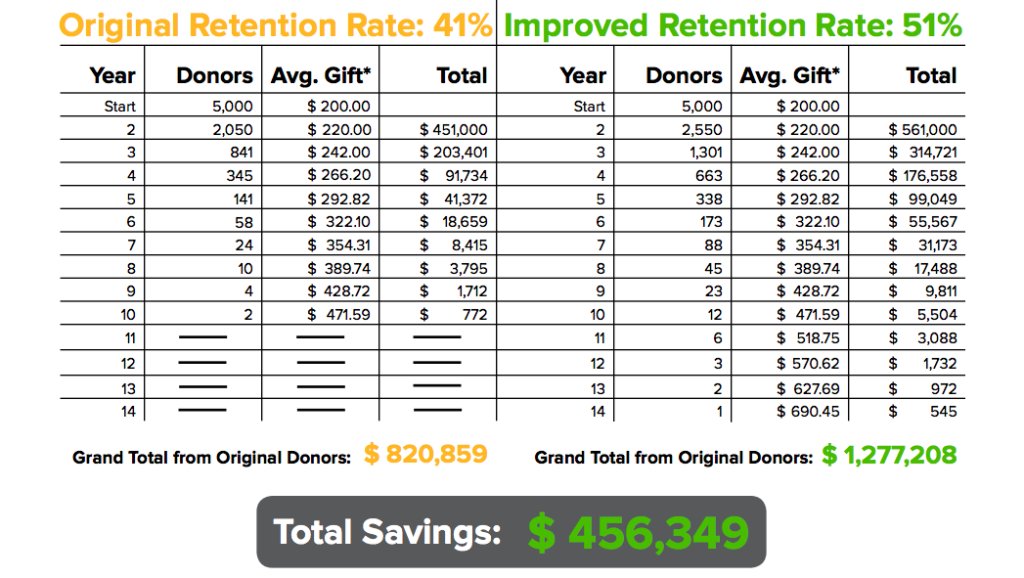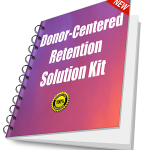By now I hope you’ve read the latest Fundraising Effectiveness Survey results and know that, on average, U.S. and UK nonprofits are retaining only 41% of their donors. This is abysmal, and it makes me sad.
When I started out in fundraising, many moons ago, I consistently retained 60 – 70% of my donors. And I thought that was insufficient!
While there are all sorts of reasons this is happening, what matters most is stopping the attrition before your nonprofit withers and dies. Because at these rates, after seven years you’ll only have 10 out of 1,000 new donors you acquire today. You read that correctly! Did I mention that first-time donor retention rates are only 27%?
Time for some magical math.
Donor retention expert Dr. Adrian Sargeant has done the research (see “Study Fundraising”) and tells us that just a 10% increase in retention today can increase the lifetime value of your donors by 200%. Let’s look at how this works.
I’m borrowing an analysis from Bloomerang, the makers of great donor software built on the principles of donor retention. Dr. Sargeant is their chief scientist. [BTW: if you’re in the market for a database, see a video of how it works here – plus a photo of me having a red day!]
This illustration uses the average retention rate of 41% and shows what happens if that rate is increased to 51% over the ensuing years. The chart below assumes a database of 5,000 donors with an average gift of $200.
Initial 5,000 Donor Chart of the Impact of a 10% Retention Change
Right off the bat, you’ll see that some of the original donors stick around four full years longer. And the total dollars raised from this same pool increases by 56%.
We’re not at 200% yet, but we’ve already improved our results significantly. Now… the magic!
While these donors are sticking around longer, other things are happening. They’re growing more loyal. They’re upgrading their gifts. They’re referring their friends, family and associates. A few are making major lifetime gifts or legacy gifts.
Here’s where donor retention magic happens.
Every year you’re keeping donors you would have lost.
Imagine one in three of these donors is responsible for bringing you one new donor either by referral or direct solicitation. This would mean that in Year 2 on this chart, the 500 extra donors you retained (10% of the initial 5,000) would yield you an extra 165 donors – all without the cost of expensive donor acquisition!
Then you do this all again the following year – compounding another year of 10% increased retention with the multiplying benefit of the additional new donor referrals.
So your pool of donors continues to build from your existing pool.
This happens every year, leading to exponential growth.
New donors are recruited by existing donors — not just from the first group of retained donors, but from every group of additional new donors added annually. Were you to add these donors and dollars into the chart every year, you would see the exponential growth that results.
And want a little more magic?
Donors recruited by other donors tend to renew at higher rates than the organization’s average retention rate!
This is due to what I call the “Good Housekeeping Seal of Approval” effect – or what principles of persuasion guru Robert Cialdini would call “social proof.” So the increased donor retention and revenue generation affect multiplies even faster!
Not all the magic is mathematical.
A lot of donor retention success has to do with your attitude.
Specifically, how much you make donors a central part of your mission, strive to help them accomplish their dreams, and show them how grateful you are to them for all they do to make our world a better place.
The more you channel an attitude of gratitude (otherwise known as building a culture of philanthropy or a customer-service focused organization), the easier it will be to ratchet up your retention rates. As you do, many other benefits will come to you.
Magic happens when people care.
When gratitude permeates your organization, and retention begins to rise, then:
- Less resources are spent on expensive acquisition and more focus can be placed on upgrading existing donors.
- More donors stick around long enough to become committed and loyal so that efforts to secure additional gifts, major gifts and legacy gifts are more fruitful.
- More retained donors creates a larger pool of potential volunteers which can yield many benefits.
- The longer a donor is retained the easier it is to recapture them if they lapse a year.
- Retained donors who continually upgrade their gifts and/or make major gifts open more doors to other higher end donors with whom they associate.
Donor retention is within your organization’s control. So… think twice the next time you’re tempted to:
- Wait an extra week (or more) to get your thank you letters out
- Be short with a donor on the phone
- Fail to add a personal note to a thank you
- Put updating your thank you letter on the back burner
- Fail to take the extra effort required to fully answer a donor’s question
- Spend all your time at your event talking to one or two donors, ignoring the rest
- Ask your donor to give again, before you’ve demonstrated the impact of their previous gift(s)
We are in an era of relationship fundraising.
It’s no longer about transactions, if it ever was. Donors today are different, and no longer give just because “it’s the right thing to do.” Nor do they give token gifts to every charity that asks.
Instead, today’s donors make impact gifts to a few charities. To the organizations where donors are persuaded that their philanthropy will have real meaning.
Part of this meaning is in the eyes of the beholder – which means you’ve done your job of transporting your donor to that place where they believe their engagement with you will help them to be the best person they can possibly be.
Begin by knowing what your current retention rate is. You can’t magically multiply if you don’t know what numbers you’re working with. Once you have your number:
- Set yourself a goal to increase it by 10%.
- Then write out a plan to get you to your goal.
- Create measurable objectives (e.g., “Retain 100% of board donors;” “Retain 30% of first-time donors;” “Retain 50% of event donors,” etc.).
- Assign staff and volunteer responsibilities so you can hold folks’ feet to the fire.
- Actively implement relationship-building strategies.
- Continue to build relationships with everything you do.
- Woo your donors; get them to commit and say “I do.”
- Manage the process.
- Evaluate what’s working; not working.
- Tweak your plan, as needed.
When you commit to donor retention you commit to donor love. Do this and you’ll have loyal supporters who will stay with you for life. They’ll take care of you, because you took care of them.
Do you have a tip for building a lasting donor relationship that’s worked for you? Please share in the comments below.
Want to Create Some Donor Retention Magic of Your Own?
Get the Donor-Centered Retention Solution Kit. It walks you step-by-step through creation of an intentional system that will maximize the lifetime value of your supporters. I’ll share with you the 9 key secrets that will boost your donor retention by leaps and bounds. Plus, you’ll be able to apply what you learn RIGHT AWAY. And, as with all Clairification products, if you’re not satisfied for any reason I have a 30-day money back guarantee. Get it here.
Photo courtesy of Freedigitalphotos.net
-
Pingback: 7 Strategies Every Nonprofit Should Master in 2017 - NonProfit PRO
-
Pingback: Top 10 Ways to Say ‘Thank You!’ to Donors
-
Pingback: Key Donor Love Strategies to Keep Nonprofit Supporters Loyal
-
Pingback: Top 11 Ways to Say ‘Thank You!’ to Donors | Bloomerang






